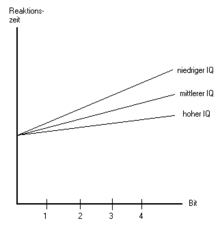Hick's law
The Hicksche law , even Hick- Hyman -law , goes to William Edmund Hick back, who thus in 1952 described the relationship between response time and number of choices. In doing so, he laid the basis for an information-theoretical model of intelligence, according to which the speed at which a person processes information is a measure of intelligence. With the Jensen -Box you can determine the reaction time in a voting decision depending on the information content. The reaction time RZ is made up of the movement time BZ and the decision time. Movement time is the time it takes to press the answer button, regardless of the information content. The decision time is the product of the information content in bits and the information processing speed IV. The information content is the binary logarithm of the number of alternatives . The formula is:
In a simple approximation, it can be assumed that for each doubling of the options in an experiment, the response time increases by approx. 150 ms.
In 1964, Roth was able to show that with more intelligent people the reaction time increases significantly more slowly with a growing number of alternatives than with less intelligent people (see graphic). The Erlangen School of Information Psychology has developed the concept of information processing speed from this .
Further investigations were carried out in traffic psychology. It was shown that with regular exercise, the reaction times, regardless of the number of options, go back to a fixed value. The graphic shows Hick's law as the upper limit of the gray area and the effect of regular repetition as the lower limit.
Web links
Individual evidence
- ^ WE Hick (1952): On the rate of gain of information . Quarterly Journal of Experimental Psychology 4, pp. 11-26
- ↑ Michael Kent: Dictionary of Sports Science and Sports Medicine , ISBN 3-7853-1615-1
- ↑ Erwin Roth (1964): The speed of processing information and its connection with intelligence. Journal for Experimental and Applied Psychology 11, pp. 616–622
- ↑ Klebelsberg, Dieter: Verkehrspsychologie , Springer Verlag, ISBN 3-540-11713-X




